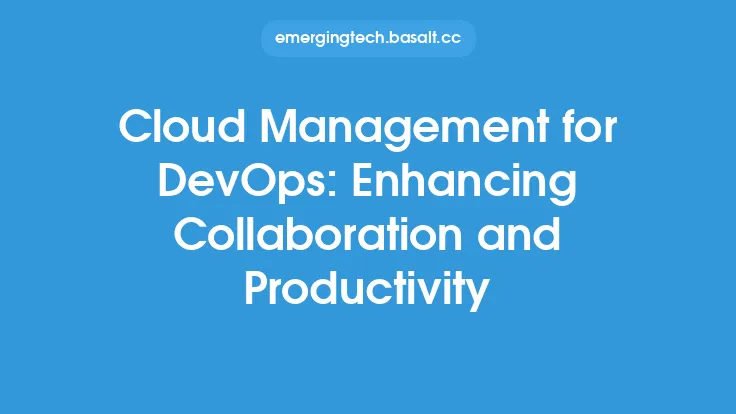Implementing Continuous Integration and Continuous Deployment (CI/CD) is a crucial aspect of cloud native application development. Cloud native applications are designed to take advantage of cloud computing principles, such as scalability, on-demand resources, and managed services. To achieve these benefits, developers need to adopt a culture of continuous delivery, where code changes are rapidly and reliably delivered to production. This is where CI/CD comes into play.
Introduction to Continuous Integration and Continuous Deployment
Continuous Integration (CI) is the practice of automatically building and testing code changes as they are committed to a version control system. This ensures that code changes are validated and verified before they are merged into the main codebase. Continuous Deployment (CD), on the other hand, is the practice of automatically deploying code changes to production after they have passed through the CI pipeline. The combination of CI and CD enables developers to deliver code changes rapidly and reliably, reducing the time and effort required to get changes to production.
Benefits of Continuous Integration and Continuous Deployment
The benefits of implementing CI/CD for cloud native applications are numerous. Firstly, it enables faster time-to-market, as code changes can be delivered to production quickly and reliably. Secondly, it improves code quality, as automated testing and validation ensure that code changes are thoroughly tested before they are deployed to production. Thirdly, it reduces the risk of human error, as automated deployment scripts ensure that code changes are deployed consistently and correctly. Finally, it enables developers to focus on writing code, rather than manually deploying and testing it.
Tools and Technologies for Continuous Integration and Continuous Deployment
There are many tools and technologies available for implementing CI/CD for cloud native applications. Some popular options include Jenkins, GitLab CI/CD, CircleCI, and Travis CI. These tools provide a range of features, including automated building and testing, deployment scripting, and monitoring and logging. Additionally, cloud providers such as Amazon Web Services (AWS), Microsoft Azure, and Google Cloud Platform (GCP) offer managed CI/CD services, such as AWS CodePipeline, Azure DevOps, and Google Cloud Build.
Implementing Continuous Integration
Implementing CI involves several steps. Firstly, developers need to set up a version control system, such as Git, to manage code changes. Secondly, they need to choose a CI tool, such as Jenkins or GitLab CI/CD, to automate the building and testing of code changes. Thirdly, they need to configure the CI tool to automatically build and test code changes as they are committed to the version control system. Finally, they need to integrate the CI tool with other tools and services, such as testing frameworks and deployment scripts.
Implementing Continuous Deployment
Implementing CD involves several steps. Firstly, developers need to choose a deployment strategy, such as rolling updates or blue-green deployments. Secondly, they need to configure the deployment script to automatically deploy code changes to production after they have passed through the CI pipeline. Thirdly, they need to integrate the deployment script with other tools and services, such as monitoring and logging tools. Finally, they need to configure the deployment script to handle rollbacks and other deployment-related tasks.
Best Practices for Continuous Integration and Continuous Deployment
There are several best practices for implementing CI/CD for cloud native applications. Firstly, developers should aim to automate as much of the CI/CD pipeline as possible, to reduce the risk of human error and improve efficiency. Secondly, they should use infrastructure-as-code (IaC) tools, such as Terraform or CloudFormation, to manage infrastructure configuration and deployment. Thirdly, they should use monitoring and logging tools, such as Prometheus or ELK, to monitor and log application performance and deployment-related metrics. Finally, they should use security and compliance tools, such as OWASP or PCI-DSS, to ensure that the CI/CD pipeline is secure and compliant with regulatory requirements.
Challenges and Limitations of Continuous Integration and Continuous Deployment
There are several challenges and limitations to implementing CI/CD for cloud native applications. Firstly, it can be difficult to automate complex deployment scripts and workflows. Secondly, it can be challenging to ensure that the CI/CD pipeline is secure and compliant with regulatory requirements. Thirdly, it can be difficult to manage and monitor the performance of the CI/CD pipeline, particularly in large and complex environments. Finally, it can be challenging to ensure that the CI/CD pipeline is aligned with business requirements and goals.
Conclusion
In conclusion, implementing CI/CD for cloud native applications is a crucial aspect of cloud native application development. It enables faster time-to-market, improves code quality, reduces the risk of human error, and enables developers to focus on writing code. By following best practices, using the right tools and technologies, and addressing challenges and limitations, developers can implement a robust and reliable CI/CD pipeline that delivers code changes rapidly and reliably to production. As cloud native applications continue to evolve and grow in complexity, the importance of CI/CD will only continue to increase, making it a critical component of any cloud native application development strategy.





